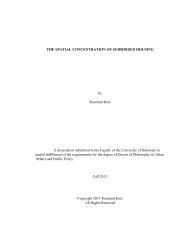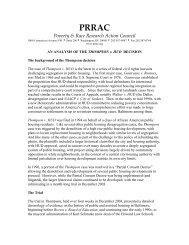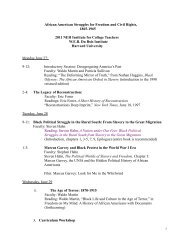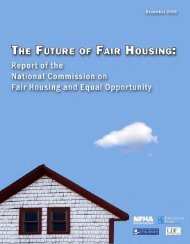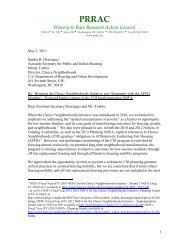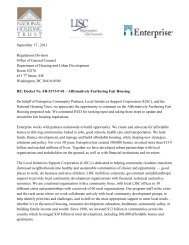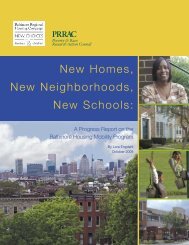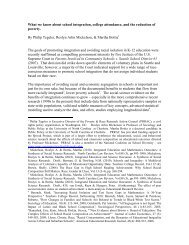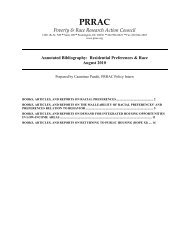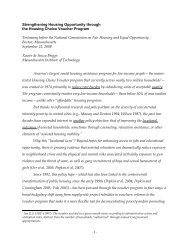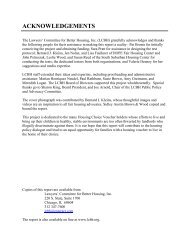Annotated Bibliography of Housing Mobility Research 2006-2010
Annotated Bibliography of Housing Mobility Research 2006-2010
Annotated Bibliography of Housing Mobility Research 2006-2010
Create successful ePaper yourself
Turn your PDF publications into a flip-book with our unique Google optimized e-Paper software.
affecting those outcomes and considers policy implications for the next generation <strong>of</strong> assisted<br />
housing mobility initiatives.<br />
Turner, Margery A. & Stephen Ross, “How racial discrimination affects the search for<br />
housing,” in The geography <strong>of</strong> opportunity: Race and housing choice in metropolitan America<br />
(Xavier de Souza Briggs, ed.), Brookings Institution Press (<strong>2006</strong>)<br />
Turney, Kristin, Susan ClampetLundquist, Kathryn Edin, Jeffrey Kling & Greg Duncan,<br />
“Neighborhood effects on barriers to employment: Results from a randomized housing mobility<br />
experiment in Baltimore,” BrookingsWharton Papers on Urban Affairs 13787 (<strong>2006</strong>)<br />
Varady, David P. & Caral C. Walker, Neighborhood Choices: Section 8 <strong>Housing</strong> Vouchers and<br />
Residential <strong>Mobility</strong>. New Brunswick, NJ: CUPR Press (2007)<br />
Summary: This book addresses the central question <strong>of</strong> whether it is possible to achieve the benefits <strong>of</strong><br />
housing mobility <strong>of</strong>fered by the Section 8 program while maximizing the degree <strong>of</strong> choice for<br />
householders. Although Gautreaux and MTO have been examined in several studies, few recent<br />
studies with the exception <strong>of</strong> Goetz’s 2003 case study <strong>of</strong> the Hollman v. Cisneros litigation<br />
settlement in Minneapolis have investigated the housing choices <strong>of</strong> residents in the regular Section<br />
8 program. This book focuses on the experiences <strong>of</strong> families receiving Section 8 housing vouchers<br />
in two programs: (1) the “vouchering out” <strong>of</strong> four federally subsidized private developments,<br />
where the residents were given only a bit more counseling than is provided in the regular program;<br />
and (2) the Section 8 program in Alameda County, where many innercity families in Oakland and<br />
Berkeley were moving to suburban locations in the county unlike in other metropolitan areas,<br />
where households with vouchers rarely cross the city/suburban boundary. Up to now, too little<br />
attention has been given to ways to improve the operation <strong>of</strong> the regular Section 8 housing voucher<br />
program. This book is aimed at reducing this gap in the literature.<br />
Wang, Xinhao, David Varady & Yimei Wang, “Measuring the Deconcentration <strong>of</strong> <strong>Housing</strong><br />
Choice Voucher Program Recipients in Eight U.S. Metropolitan Areas Using Hot Spot<br />
Analysis,” Cityscape 10(1): 6590 (2008)<br />
Abstract:<br />
Describes the use <strong>of</strong> hot spot analysis to measure changes in the clustering <strong>of</strong> U.S. Department <strong>of</strong><br />
<strong>Housing</strong> and Urban Development (HUD) <strong>Housing</strong> Choice Voucher Program (HCVP) recipients.<br />
Hot spot analysis for HCVP recipients in eight metropolitan areas (New York, Baltimore, Chicago,<br />
Cincinnati, Miami, Houston, Los Angeles, and Phoenix) was performed using the tenantbased<br />
data system from HUD’s Office <strong>of</strong> Public and Indian <strong>Housing</strong>. The 2000 and 2005 hot spots were<br />
overlaid with 2000 Census block group data. The hot spot results show that the tendency <strong>of</strong> HCVP<br />
households to cluster varies by metropolitan area; however, no evidence indicates that HCVP<br />
clustering is declining. Although HCVPs are becoming less concentrated in hot spots in Chicago<br />
and Phoenix, the opposite is true in other metropolitan areas, especially in New York, Cincinnati,<br />
and Baltimore. This type <strong>of</strong> HCVP concentration is likely to continue as long as affordable rental<br />
housing is confined largely to central cities and older inner suburbs.<br />
Weismann, Gretchen, “The Relative Risk: Parenting, Peers, and Poverty in the ThreeCity<br />
Study <strong>of</strong> Moving to Opportunity,” Unpublished Ph.D. dissertation, Department <strong>of</strong> Urban<br />
Studies and Planning, Massachusetts Institute <strong>of</strong> Technology (2008). Available at:<br />
http://dspace.mit.edu/handle/1721.1/44365show=full<br />
Abstract:<br />
Using the Three City Study <strong>of</strong> Moving to Opportunity (Boston, Los Angeles, and New York), this<br />
20



